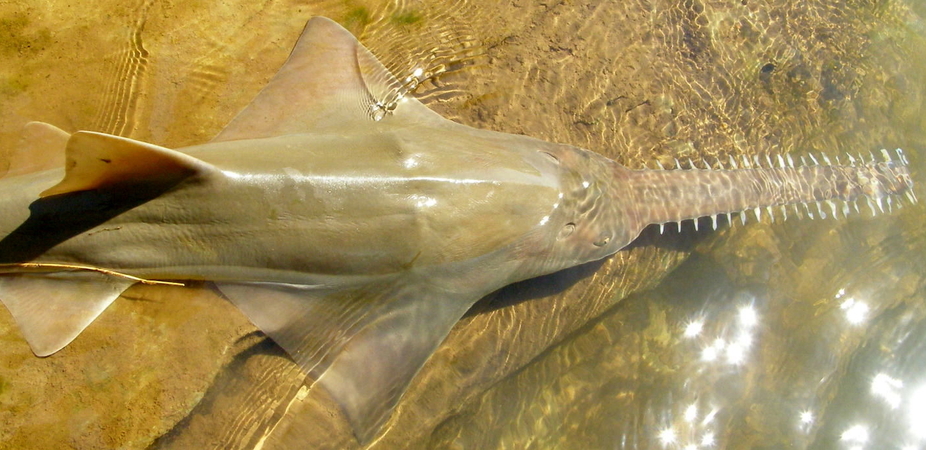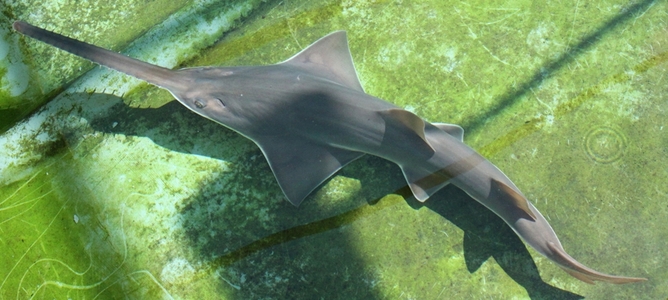
Australian Endangered Species: Largetooth Sawfish

This article was originally published at The Conversation. The publication contributed the article to Live Science's Expert Voices: Op-Ed & Insights.
Sharks and rays are some of the world’s most threatened animals, with a quarter of all species at risk of extinction. Among the sharks and rays, sawfish are some of the most threatened, with all five species listed as Critically Endangered or Endangered by the International Union for Conservation of Nature (IUCN).
The Largetooth Sawfish (Pristis pristis), previously known locally as the Freshwater Sawfish, is one of the planet’s largest fish, growing to over 6.5m in length.
The Largetooth Sawfish is a “euryhaline” species: capable of moving freely across a range of salinities from pure freshwater to the oceans. Its life cycle is complex and fascinating, encompassing a wide variety of habitats – floodplains, billabongs, creeks, rivers, estuaries and marine waters.
Young Largetooth Sawfish are born in estuaries before migrating upstream to spend their first 4-5 years of life in river systems. Locally they have been recorded up to 400 kilometres from the coast in the Fitzroy River. Upon nearing maturity they move back to coastal and marine waters.
Status
Historically the Largetooth Sawfish was a wide-ranging species of tropical regions with four distinct populations – eastern Atlantic, western Atlantic, eastern Pacific and the Indo-west Pacific. It is now extinct or severely depleted across much of this range and is globally listed by the IUCN as Critically Endangered.
Northern Australia represents one of the only remaining population strongholds for this sawfish and although it has also declined significantly here, it is holding on.
Sign up for the Live Science daily newsletter now
Get the world’s most fascinating discoveries delivered straight to your inbox.
The relatively pristine nature of large northern Australian rivers are essential for juvenile Largetooth Sawfish. We have some understanding of the importance of rivers such as the Fitzroy River in the Kimberley and the Daly River in the Top End. However, we know little about the adult population.
Is the species still declining, or are protection and fisheries-management measures working? A research project is focusing on this question, using new genetic techniques to understand the species’ status.

Threats
Unregulated and unmanaged fisheries, and habitat loss and degradation, all threaten sawfish across the globe. Their long-toothed snout (or “rostrum”) is easily entangled in nets, making them susceptible to capture in a variety of fishing gear. Sawfish products, particularly their fins (used for shark fin soup) and their rostrum (sold as a curio) are highly valued.
Sawfish have not been commercially targeted in Australia, but have suffered from incidental capture (“bycatch”) in northern Australian gillnet and trawl fisheries. This has severely impacted Australian populations. Some fisheries now have a code of conduct to release sawfish alive, but large individuals can be difficult to handle and death from commercial fishing is an ongoing issue.
The Largetooth Sawfish is encountered on occasion by recreational fishers and there have been instances of illegal harvest, including retaining the rostrum as a trophy. Fishers can follow simple guidelines to release sawfish safely.
There is considerable pressure to develop the freshwater resources of northern Australia, but proposals will firmly need to consider impacts on Largetooth Sawfish. Structures such as dams and barrages in rivers are barriers to sawfish migration, while dry season water extraction could reduce available river habitat. Connectivity from estuaries through to upstream reaches of rivers is essential for allowing the species to complete its lifecycle.
Sawfish survival from Northern Biodiversity on Vimeo.
Strategy
Globally, the IUCN Shark Specialist Group will soon release its Global Sawfish Conservation Strategy which outlines a series of global objectives and actions to meet its vision: “a world where sawfishes are restored to robust populations within thriving aquatic ecosystems.”
These include improved fisheries management, strategic research, species and habitat protection, trade limitation, capacity building, outreach and fundraising.
Nationally, Australia has shown a strong commitment to sawfish conservation, particularly important given the significance of our waters for sawfishes. The Largetooth Sawfish, along with the Dwarf Sawfish and the Green Sawfish are completely protected throughout Australia.
The Narrow Sawfish has not been afforded that level of protection but its global threatened status warrants it, and Australia has an opportunity to continue its leadership in sawfish conservation by fully protecting this species.
A multi-species recovery plan for sawfishes and endangered river sharks is currently available for public comment. The challenge will be to turn these actions into real conservation benefits.
Conclusion
The importance of northern Australia for Largetooth Sawfish and the other three species of threatened sawfishes which occur here cannot be overlooked. Northern Australia is like a “lifeboat” for sawfish; if they have disappeared elsewhere, Australia may be their last hope.
Peter Kyne receives funding from the Marine Biodiversity Hub and the Northern Australia Hub, collaborative partnerships supported through funding from the Australian Government’s National Environmental Research Program (NERP). He is Regional Vice-Chair of the Australia and Oceania IUCN Shark Specialist Group.
This article was originally published on The Conversation. Read the original article. Follow all of the Expert Voices issues and debates — and become part of the discussion — on Facebook, Twitter and Google +. The views expressed are those of the author and do not necessarily reflect the views of the publisher. This version of the article was originally published on Live Science.









